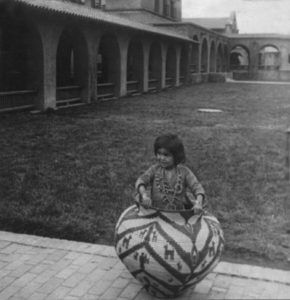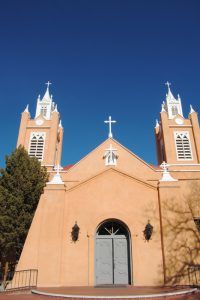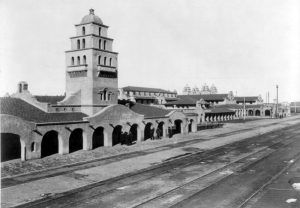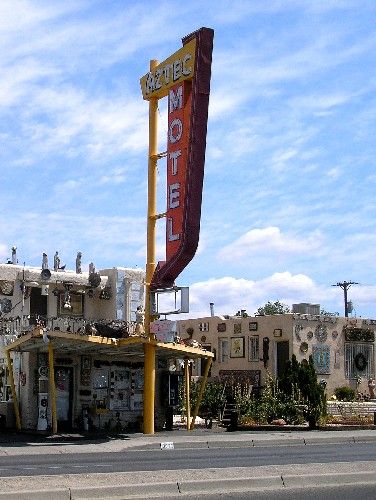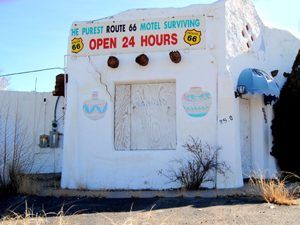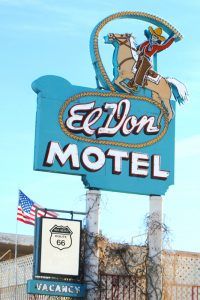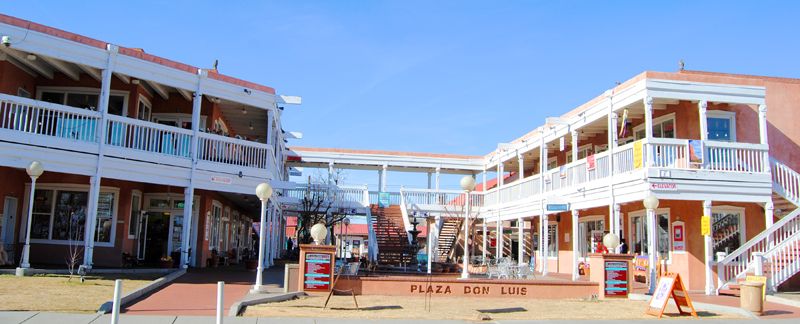Albuquerque, New Mexico – 300 Year Old Duke City – Legends of America (original) (raw)
Indian girl in a basket in Albuquerque, New Mexico, 1920.
Albuquerque’s history dates back 12,000 years when the first American Indians settled there. Ancient Puebloan Indians (Anasazi) lived in the area between 1000 and 1300, planting corn, beans, and squash and constructing adobe and brick pit homes along the banks of the Rio Grande. They also established several communities throughout northeastern New Mexico, connecting them with sophisticated roads.
Then, in 1540, Conquistador Francisco Vasquez de Coronado came north from Mexico searching for the mythical Seven Cities of Cibola. Though Coronado left empty-handed, it didn’t stop even more Spanish settlers from arriving in the area, looking for the elusive gold. The Pueblo Rebellion of 1680 discouraged further settlement until Spanish General Don Diego de Vargas arrived in 1692. By the end of the 17th century, several trading posts were established just north of the present-day city.
The San Felipe de Neri Church on the Old Town Plaza in Albuquerque, New Mexico, was built in 1793. It is one of the oldest surviving buildings in the city. Photo by Kathy Alexander.
By the beginning of the 18th century, the area that would become Albuquerque was called Bosque Grande de San Francisco Xavier. In 1706, the ambitious provisional governor of the territory, Don Francisco Cuervo y Valdez, petitioned the Spanish government to establish the bosque as a formal villa and call it Albuquerque, after Viceroy Francisco Fernandez de la Cueva, the Duke of Albuquerque. Later, the spelling was changed because some influential person couldn’t pronounce the “R” in Albuquerque. The city is still nicknamed “Duke City.”
During much of the 18th and 19th centuries, Albuquerque was little more than a dusty trading center along the El Camino Real, the trail linking Mexico and Santa Fe. Close-knit families of Spanish descent accounted for most of the population living around the central plaza in Old Town.
This began to change when Josiah Gregg, a frontiersman and trailblazer, established the Old Fort Smith Wagon Road between Arkansas and Santa Fe in 1839. People cared little about the trail for ten years until the California Gold Rush of 1849, when it became heavily traveled by those pioneers seeking their fortunes in the far west.
In 1846, the United States claimed the territory when General Stephen Kearny established an army post. During the Civil War, Confederate troops briefly occupied Albuquerque, and after the war was over, white merchants and tradesmen arrived in numbers.
Santa Fe Railroad Station, Albuquerque, New Mexico, 1903.
When the railroad steamed through in 1880, the city changed drastically, bringing in hundreds of white settlers and changing the demographics and architecture of the city. Numerous new businesses were established around the new railroad, and the city began to grow. By 1885, Albuquerque was incorporated.
In 1889, the University of New Mexico was founded in Albuquerque, bringing with it not only knowledge but also new and different cultures to the community.
Growth continued steadily into the 20th century and saw another spurt when Route 66 brought a steady stream of traffic through the city. Before the 1930s, Albuquerque’s Main Street, now Central Avenue, consisted of a few motor courts, gas stations, campgrounds, and cafes. In no time at all, new motels, restaurants, and services, complete with neon signs, began competing for Mother Road travelers’ attention. A cafe shaped like an iceberg opened for business on the present site of the Lobo Theatre; a sombrero-shaped restaurant offered Mexican food, and the Aztec Lodge and De Anza Motor Lodge presented pueblo-inspired accommodations.
Aztec Motel, Albuquerque, New Mexico, by Kathy Alexander.
When the realignment of Route 66 was completed in 1937, there were more motels on Central Avenue than built in the previous 10 to 12 years on the other alignment. By 1955, there were more than 100 motels on Albuquerque’s Central Avenue, but finding an open room in the summer was hard.
The Aztec Motel was the oldest surviving Route 66 motel in New Mexico until 2011. Beginning as the Aztec Auto Court in 1933, it was built four years before Central Avenue became Route 66. An example of the Southwest Vernacular style, it was the first of what would eventually be dozens of auto courts lining Central Avenue. The motel changed hands several times over the years. When Interstate 40 bypassed Central Avenue, the booming business of the auto court faltered dramatically, and the motel fell into disrepair and disrepute, becoming a haven for prostitutes and drug dealers.
In 1991, however, a new owner purchased the Aztec. With patience, hard work, and creativity, the new proprietor returned the motel to working as a short- and long-term motel. The old auto court continued to serve Route 66 travelers for 20 years, but, unfortunately, due to its condition and renovation costs, it was razed in 2011.
El Vado Motel, Albuquerque, New Mexico, before it was restored by Kathy Alexander.
El Vado Motel was built in 1937 by a former Franciscan Hotel manager in downtown Albuquerque. This enclosed motor court, built of adobe in the Pueblo Revival style, is considered the city’s purest surviving Route 66 motel. Previous owners turned down attractive offers for the motel’s neon Indian through the years.
The motel was sold in 2005 to a developer who planned to raze the old hotel to build townhouses. However, Route 66 enthusiasts and historic preservationists lobbied to save the old auto court. The city of Albuquerque then stepped in and saved El Vado. Plans were made to refurbish the site in a mixed-use development, including a community food court, an amphitheater, a boutique motel, and a small events center. The “new” El Vado celebrated its grand opening in July 2018.
El Don Motel, Albuquerque, New Mexico, by Kathy Alexander.
In 1959, Albuquerque’s vintage Route 66 suffered a blow when I-40 plowed through the city, circumventing the narrow road of Route 66. Though much of the Route 66-era roadside architecture was lost with the advent of the interstate, Albuquerque still provides several Mother Road icons and a wealth of historical sites for the nostalgic traveler.
A trip down Central Avenue at night is a trip back in time as you view the numerous neon lights sparkling along Route 66. You can still see many Route 66 iconic motels, such as the De Anza Motel, the Tewa Motel, the Luna Lodge, and the Town Lodge Motel. Check out Nob Hill, built in 1936-47, and the Lobo Theater and Lobo Pharmacy & Bookstore (originally Barber’s El Rancho Market), built in the 1930s.
Downtown, several buildings were highlights in the 1940s and 50s era, including the Sunshine Building (built in 1923-24), the First National Bank Building (1922), the Rosenwald Building (1910), and the KiMo Theater (1927). Other sites west of Old Town include Lindy’s Restaurant (1929), Maisel’s (circa 1940), and the El Vado Motel (1937).
While in Albuquerque, you must also see Old Town, a preserved Spanish plaza, take a scenic train ride, and visit the New Mexico Museum of Natural History to get the entire Albuquerque experience.
When traveling Route 66 westward from Albuquerque, there are two alignments. The pre-1937 alignment, though out of the way, is most interesting as it passes through several ghost towns with numerous peeks at the long-ago past. To drive the older alignment, you will leave Albuquerque, heading south on NM 314 just after crossing the Rio Grande, then turn west on NM6 at Los Lunas. The post-1937 alignment leaves the city on Central Avenue, crosses the Rio Grande, and climbs Nine-Mile Hill to join I-40. The two alignments converge again near the village of Mesita.
Old Town Albuquerque, New Mexico, by Kathy Alexander
© Kathy Alexander/Legends of America, updated February 2024.
